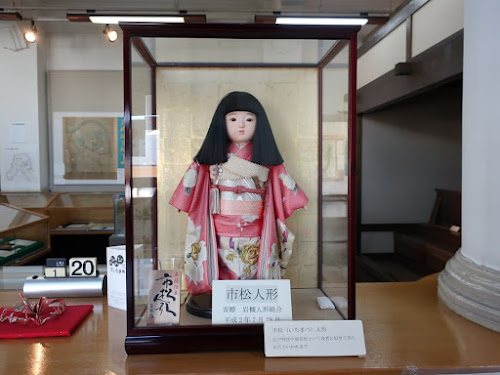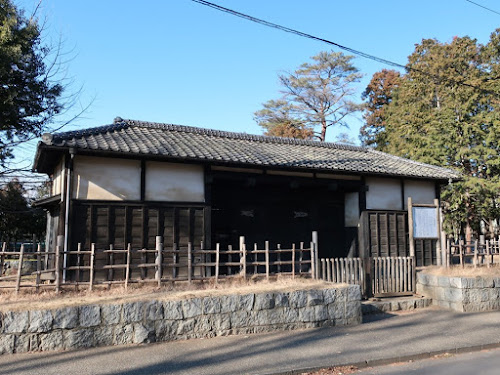This museum is north of Tokyo, just 30km away. Iwatsuki was a
strategic base in the Edoperiod (1603~1868), but it is popular as a doll city now.
It shows actual
livelihood of ordinary people such as cool stamps of a tea trader. The fun of
the people are found in a festival or an event. Frying kites and Sumo wrestling
performance attracts me.
東京の北、30kmに位置し、重要な戦略拠点である岩槻城を擁した岩槻。今は、人形の町として人気である。使い込まれた茶商のはんこなど人の暮らしを実感させてくれる展示だ。でも、楽しみと言えば、祭りやイベントですね。凧揚げや土俵入りの写真が素敵でした。
This
rusty museum was built in 1930 as a police office, ant this is designated as a
national cultural asset.
この渋い資料館は、1930年に建てられた岩槻警察署であった。アールデコ調の素敵な建物で、国の有形文化財になっている。
This doll is in the entrance, here is a
doll town!
資料館に入るとまず、人形。さすが、人形の町だ。
Hagoita (racket of Japanese badminton) and
miniature weapons (left) 、羽子板と武具のミニチュア
History of Iwatsuki、岩槻の歩み
The model of Iwatsuki castle is in the
center of the room, and the tea leaf merchant shop is installed on the behind.
岩槻城の模型を中央に据え、茶商の店先を奥に置いた展示室
Iwatsuki castle、岩槻城の紹介コーナー
This funny picture shows a man who sold
Kawarake clay cups which were used as disposable cups for parties.
「カワラケ売り」という絵があった。カワラケは、宴席で使われる使い捨ての素焼きの酒器で、各所で多量に発掘されている。馬が暴れてカワラケが散乱している。何か面白い絵だ。
This is a very good display, because we
can know the hometowns of the ceramic fragments.
中国、韓国や日本各地から様々な陶磁器が岩槻に来たことが実物で示されている。ユニークな展示だ。
This cup was found at a samurai house. The
cup was repaired, and we can know that there were repairing craftsmen in the 19th
century. Japanese take care of goods very well.
武家屋敷跡から発掘された江戸時代末頃の茶碗。壊れた陶器を修理した焼き継ぎ屋という仕事があり、その補修の跡があるという。本当に、物を大切にしていた時代だ。
Tea shop、茶商
The shop front of the tea leaf merchant
which has traditional equipment.
茶商の店先。味わいがある道具が揃っている。
Stamps of tea brands.
茶商のはんこ、茶の銘柄。いい感じ。
Stamps of tea shops. I like these.
茶商のはんこ、店の名前。こちらもいい。
Everyday goods、くらしの道具
There is a kite near the ceiling.
展示室の中央に凧が上がっている
Traditional sumo wrestling ring entering
ritual and decorated belts. This is a passage ritual for children.
岩槻の古式土俵入り(重要無形民俗文化財)の化粧まわしと写真。子供の通過儀礼として土俵入りを繰り広げる。
There are many participants, but I’m not
sure why there were so many flags of foreign countries.
参加者が多い。良く見ると万国旗が吊るされていてちょっと不思議だ。
The kite flying was held in June until
1960. Kasukabe city, which is near Iwatsyki, hosts similar event even now.
Reference(参考):
http://www.city.kasukabe.lg.jp/bunka_sports/kankou/oodakomatsuri/index.html
岩槻の大凧あげ。1960年頃まで、毎年6月5日に行われていた。近くの春日部では今も5月3日と5日に大凧あげが行われている。
This palanquin (replica) was used by a
doctor until 19th century.
江戸時代末期に助産所の医師が往診に使用していた駕篭を復元したもの。立派な籠だ。
I’m not sure this was comfortable or not.
駕篭の乗り心地は???
Tableware, kitchenware and heaters (lower
shelf); During a wedding or a funeral, dishes on a formal tray (Honzen) were
served. Dozens of trays and tableware were needed during events, so people
borrowed them from neighbors or made a joint purchase. It was a nice mutual aid.
食生活の道具と暖房器具。冠婚葬祭に使われた。食器が数十人分が必要になるので共同購入したり、借りたりしていたそうだ。住民の互助が生きている。
These were used while chanting a Buddhist
sutra. Women gathered, rotated the long beadroll and prayed for their ancestors
and happiness.
百万遍の数珠と鉦。多くの女性が集まって、供養や豊作のために祈ったのだろう。数珠を回しして数を数える。
Photo of a rice planting 1/3 : banding a
young plant
田植の写真。苗を束ねる。
2/3: throwing young plants、苗の束を撒く。
3/3: women also planted which was a very
hard job.
植える。大変な作業だし、女性が働いている。
Farmers’ work garments、農家の作業着
Life in the ancient era、大昔のくらし
This horned owl clay doll is so cute.
ミミズク土偶がなんとも可愛い
Walking around Iwatsuki、岩槻めぐり
The ruin of Iwatsuki castle is a citizens’
park now.
岩槻城址の公園。いまや市民の憩いの場だ。
This black building might have been the
gate of Iwatsuki castle.
岩槻城城門と言われる黒門、風格がある。
Senkyoukan (School of Iwatsuki han)、旧岩槻藩藩校・遷喬館
Simple but dignified entrance、立派な玄関
Classroom、教場
Writings of Mr. Kodama who was the founder
of this school @ Iwatsuki Saitama Local History Museum
遷喬館を創設者・児玉氏の著作@岩槻郷土資料館。背筋が伸びる感じがする。
Time bell which was rebuilt in 1720.
時の鐘。現在の鐘は二代目で1720年に作られた。
The names of executive carpenters who were
engaged in the renovation project in 1853 are written on this board. I worked in
the same industry, so I have a particular feeling to this plate.
時の鐘の棟札@岩槻郷土資料館。1853年の改修時のもので、普請奉行や大工など工事関係者の名前に同業として親しみを感じた。
In front of the Iwatsuki station. There
are many doll manufacturers here.
人形の町、岩槻の駅前
Hina dolls for Girls’ Festival on third of
March. The price of this dolls was $3,500; I think it was inexpensive.
三段飾り@中島敏人形:雛人形の販売時期だった。美しく立派な本品は39万円だったが、安いと思う。
Nine funs(楽fun)were found. Visited in January, 2019
Website: https://www.city.saitama.jp/004/005/004/005/009/p009074.html
(in Japanese), accessed in June, 2020
Previous post (The largest history museum of this prefecture):
Next post (Local
museum int the same prefecture, Saitama):





































Comments
Post a Comment